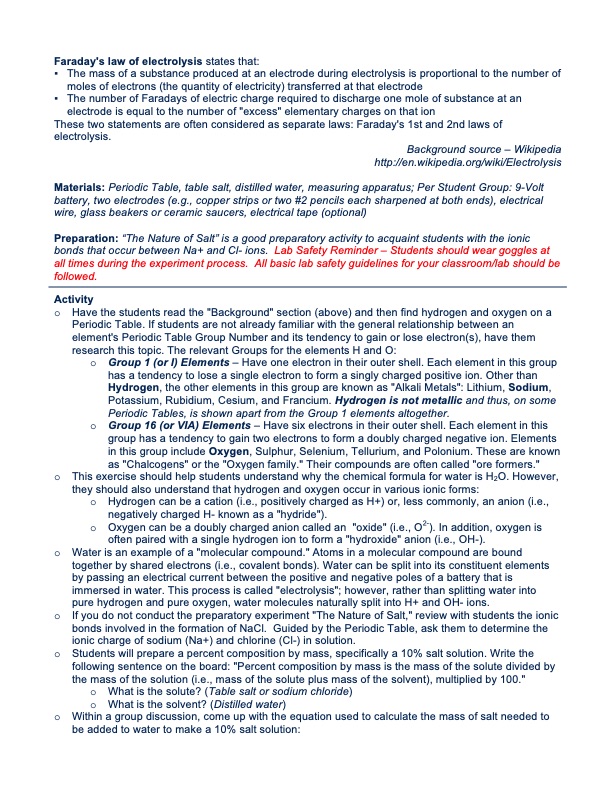
PDF Publication Title:
Text from PDF Page: 003
Faraday's law of electrolysis states that: ▪ The mass of a substance produced at an electrode during electrolysis is proportional to the number of moles of electrons (the quantity of electricity) transferred at that electrode ▪ The number of Faradays of electric charge required to discharge one mole of substance at an electrode is equal to the number of "excess" elementary charges on that ion These two statements are often considered as separate laws: Faraday's 1st and 2nd laws of electrolysis. Background source – Wikipedia http://en.wikipedia.org/wiki/Electrolysis Materials: Periodic Table, table salt, distilled water, measuring apparatus; Per Student Group: 9-Volt battery, two electrodes (e.g., copper strips or two #2 pencils each sharpened at both ends), electrical wire, glass beakers or ceramic saucers, electrical tape (optional) Preparation: “The Nature of Salt” is a good preparatory activity to acquaint students with the ionic bonds that occur between Na+ and Cl- ions. Lab Safety Reminder – Students should wear goggles at all times during the experiment process. All basic lab safety guidelines for your classroom/lab should be followed. Activity o Havethestudentsreadthe"Background"section(above)andthenfindhydrogenandoxygenona Periodic Table. If students are not already familiar with the general relationship between an element's Periodic Table Group Number and its tendency to gain or lose electron(s), have them research this topic. The relevant Groups for the elements H and O: o Group1(orI)Elements–Haveoneelectronintheiroutershell.Eachelementinthisgroup has a tendency to lose a single electron to form a singly charged positive ion. Other than Hydrogen, the other elements in this group are known as "Alkali Metals": Lithium, Sodium, Potassium, Rubidium, Cesium, and Francium. Hydrogen is not metallic and thus, on some Periodic Tables, is shown apart from the Group 1 elements altogether. o Group16(orVIA)Elements–Havesixelectronsintheiroutershell.Eachelementinthis group has a tendency to gain two electrons to form a doubly charged negative ion. Elements in this group include Oxygen, Sulphur, Selenium, Tellurium, and Polonium. These are known as "Chalcogens" or the "Oxygen family." Their compounds are often called "ore formers." o ThisexerciseshouldhelpstudentsunderstandwhythechemicalformulaforwaterisH2O.However, they should also understand that hydrogen and oxygen occur in various ionic forms: o Hydrogencanbeacation(i.e.,positivelychargedasH+)or,lesscommonly,ananion(i.e., negatively charged H- known as a "hydride"). o Oxygen can be a doubly charged anion called an "oxide" (i.e., O2-). In addition, oxygen is often paired with a single hydrogen ion to form a "hydroxide" anion (i.e., OH-). o Waterisanexampleofa"molecularcompound."Atomsinamolecularcompoundarebound together by shared electrons (i.e., covalent bonds). Water can be split into its constituent elements by passing an electrical current between the positive and negative poles of a battery that is immersed in water. This process is called "electrolysis"; however, rather than splitting water into pure hydrogen and pure oxygen, water molecules naturally split into H+ and OH- ions. o Ifyoudonotconductthepreparatoryexperiment"TheNatureofSalt,"reviewwithstudentstheionic bonds involved in the formation of NaCl. Guided by the Periodic Table, ask them to determine the ionic charge of sodium (Na+) and chlorine (Cl-) in solution. o Studentswillprepareapercentcompositionbymass,specificallya10%saltsolution.Writethe following sentence on the board: "Percent composition by mass is the mass of the solute divided by the mass of the solution (i.e., mass of the solute plus mass of the solvent), multiplied by 100." o Whatisthesolute?(Tablesaltorsodiumchloride) o Whatisthesolvent?(Distilledwater) o Withinagroupdiscussion,comeupwiththeequationusedtocalculatethemassofsaltneededto be added to water to make a 10% salt solution:PDF Image | ELECTROLYSIS OF SALT WATER

PDF Search Title:
ELECTROLYSIS OF SALT WATEROriginal File Name Searched:
electrolysis.pdfDIY PDF Search: Google It | Yahoo | Bing
Product and Development Focus for Salgenx
Redox Flow Battery Technology: With the advent of the new USA tax credits for producing and selling batteries ($35/kW) we are focussing on a simple flow battery using shipping containers as the modular electrolyte storage units with tax credits up to $140,000 per system. Our main focus is on the salt battery. This battery can be used for both thermal and electrical storage applications. We call it the Cogeneration Battery or Cogen Battery. One project is converting salt (brine) based water conditioners to simultaneously produce power. In addition, there are many opportunities to extract Lithium from brine (salt lakes, groundwater, and producer water).Salt water or brine are huge sources for lithium. Most of the worlds lithium is acquired from a brine source. It's even in seawater in a low concentration. Brine is also a byproduct of huge powerplants, which can now use that as an electrolyte and a huge flow battery (which allows storage at the source).We welcome any business and equipment inquiries, as well as licensing our flow battery manufacturing.| CONTACT TEL: 608-238-6001 Email: greg@salgenx.com | RSS | AMP |